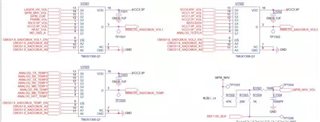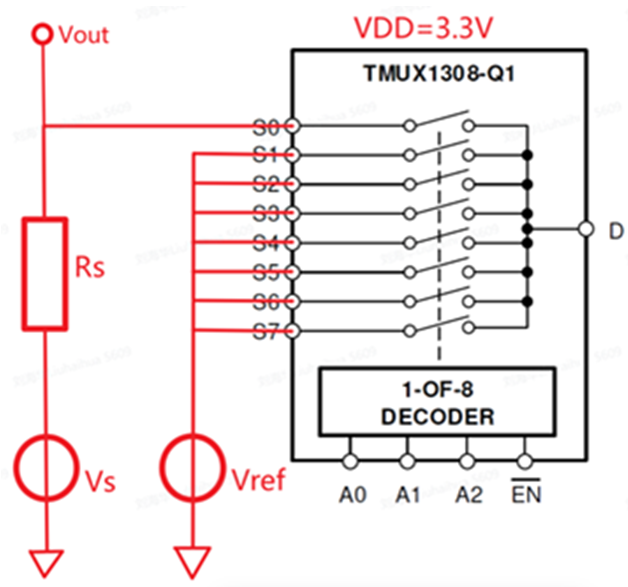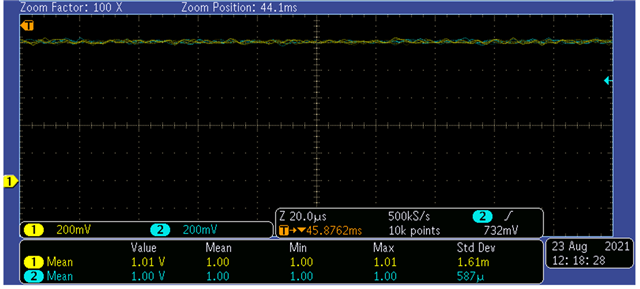Other Parts Discussed in Thread: TMUX1208
Hi Team,
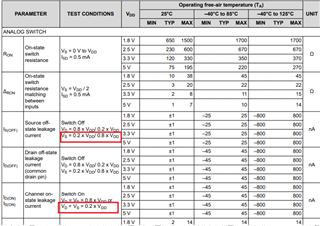
My customer test the Is current (result is uA)and found it is quite different from datasheet(nA).
Under various test conditions, the minimum leakage current at high temperature is several uA, and the maximum leakage current is tens of uA, which is much different from the datasheet 800nA.
The test circuit is as following:
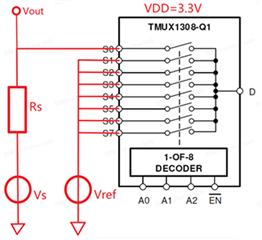
Rs=2k,Vs=0V,Vref=1.0V,The variable is temp
|
Temp of 1308/°C |
△Vout/mV |
Is/uA |
Rs/kOHM |
|
50 |
3.825 |
1.912021995 |
2.0005 |
|
60 |
7.275 |
3.636590852 |
2.0005 |
|
66 |
10.225 |
5.111222194 |
2.0005 |
|
70 |
13.2 |
6.598350412 |
2.0005 |
|
80 |
19.7 |
9.847538115 |
2.0005 |
|
90 |
27.475 |
13.73406648 |
2.0005 |
|
100 |
39.525 |
19.75756061 |
2.0005 |
|
105 |
45.6 |
22.79430142 |
2.0005 |
Rs=100k,Vs=0V,Vref=1.0V,The variable is temp
|
Temp of 1308/°C |
△Vout/mV |
Is/uA |
Rs/kOHM |
|
40 |
37.825 |
0.37825 |
100 |
|
50 |
55.225 |
0.55225 |
100 |
|
60 |
87.025 |
0.87025 |
100 |
|
70 |
119.175 |
1.19175 |
100 |
|
80 |
165.275 |
1.65275 |
100 |
|
90 |
204.175 |
2.04175 |
100 |
|
100 |
250.2 |
2.502 |
100 |
|
105 |
264.425 |
2.64425 |
100 |
|
110 |
289.55 |
2.8955 |
100 |
|
120 |
324.8 |
3.248 |
100 |
Rs=100k,Vref=1.0V,temp is 65℃,The variable is Vs
|
Rs voltage |
△Vout/mV |
Rs=100kOHM |
Is/uA |
|
0 |
61.531 |
100 |
0.61531 |
|
50 |
63.117 |
100 |
0.63117 |
|
100 |
57.515 |
100 |
0.57515 |
|
150 |
57.715 |
100 |
0.57715 |
|
200 |
51.795 |
100 |
0.51795 |
|
250 |
42.321 |
100 |
0.42321 |
|
300 |
35.403 |
100 |
0.35403 |
|
350 |
24.307 |
100 |
0.24307 |
|
400 |
12.71 |
100 |
0.1271 |
|
450 |
1.164 |
100 |
0.01164 |
|
500 |
-14.897 |
100 |
-0.14897 |
|
550 |
-39.376 |
100 |
-0.39376 |
|
600 |
-57.771 |
100 |
-0.57771 |
|
650 |
-80.305 |
100 |
-0.80305 |
|
700 |
-106.282 |
100 |
-1.06282 |
|
750 |
-128.505 |
100 |
-1.28505 |
|
800 |
-153.719 |
100 |
-1.53719 |
|
850 |
-188.735 |
100 |
-1.88735 |
|
900 |
-216.93 |
100 |
-2.1693 |
|
950 |
-250.29 |
100 |
-2.5029 |
|
1000 |
-280.373 |
100 |
-2.80373 |
Do you have some advice about how to achieve nA Is?






